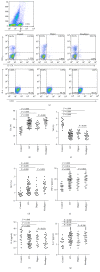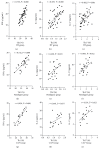Circulating Th1, Th2, and Th17 Levels in Hypertensive Patients
- PMID: 28757677
- PMCID: PMC5516715
- DOI: 10.1155/2017/7146290
Circulating Th1, Th2, and Th17 Levels in Hypertensive Patients
Abstract
Background: Evidence from experimental studies showed that Th1, Th2, and Th17 play a pivotal role in hypertension and target organ damage. However, whether changes in the circulating Th1, Th2, and Th17 levels are associated with nondipper hypertension and carotid atherosclerotic plaque in hypertension has yet to be investigated.
Methods: Th1, Th2, and Th17 levels were detected using a flow cytometric analysis, and their related cytokines were measured by enzyme-linked immunosorbent assay in 45 hypertensive patients and 15 normotensive subjects.
Results: The frequencies of Th1 and Th17 in hypertensive patients, especially in nondipper patients and patients with carotid atherosclerotic plaque, were markedly higher than those in the control group; this was accompanied by higher IFN-γ and IL-17 levels. In contrast, the Th2 frequencies and IL-4 levels in hypertensive patients, especially in nondipper patients and patients with carotid atherosclerotic plaque, were significantly lower than those in the control group.
Conclusions: The changes in Th1, Th2, and Th17 activity are associated with the onset of the nondipper type and carotid atherosclerotic plaque in hypertensive patients.
Figures



Similar articles
-
Acitretin exerted a greater influence on T-helper (Th)1 and Th17 than on Th2 cells in treatment of psoriasis vulgaris.J Dermatol. 2012 Nov;39(11):916-21. doi: 10.1111/j.1346-8138.2012.01637.x. Epub 2012 Aug 23. J Dermatol. 2012. PMID: 22913391
-
Profile of Th17 cytokines (IL-17, TGF-beta, IL-6) and Th1 cytokine (IFN-gamma) in patients with immune thrombocytopenic purpura.Ann Hematol. 2008 Nov;87(11):899-904. doi: 10.1007/s00277-008-0535-3. Epub 2008 Jul 4. Ann Hematol. 2008. PMID: 18600325
-
The effect of dimethyl fumarate on gene expression and the level of cytokines related to different T helper cell subsets in peripheral blood mononuclear cells of patients with psoriasis.Int J Dermatol. 2015 Jul;54(7):e254-60. doi: 10.1111/ijd.12834. Int J Dermatol. 2015. PMID: 26108267
-
The 1996 Moyer Award. Effects of endotoxin on the Th1/Th2 response in humans.J Burn Care Rehabil. 1996 Nov-Dec;17(6 Pt 1):491-6. J Burn Care Rehabil. 1996. PMID: 8951535 Review.
-
Th17 cells: a new fate for differentiating helper T cells.Immunol Res. 2008;41(2):87-102. doi: 10.1007/s12026-007-8014-9. Immunol Res. 2008. PMID: 18172584 Review.
Cited by
-
Vascular consequences of inflammation: a position statement from the ESH Working Group on Vascular Structure and Function and the ARTERY Society.J Hypertens. 2020 Sep;38(9):1682-1698. doi: 10.1097/HJH.0000000000002508. J Hypertens. 2020. PMID: 32649623 Free PMC article. Review.
-
T-Cell Accumulation in the Hypertensive Brain: A Role for Sphingosine-1-Phosphate-Mediated Chemotaxis.Int J Mol Sci. 2019 Jan 28;20(3):537. doi: 10.3390/ijms20030537. Int J Mol Sci. 2019. PMID: 30695999 Free PMC article.
-
The Impact of Hypertension and Use of Calcium Channel Blockers on Tuberculosis Treatment Outcomes.Clin Infect Dis. 2021 Nov 2;73(9):e3409-e3418. doi: 10.1093/cid/ciaa1446. Clin Infect Dis. 2021. PMID: 32971534 Free PMC article.
-
The Increased Risk of Hypertension Caused by Irrational Dietary Pattern May Be Associated with Th17 Cell in the Middle-Aged and Elderly Rural Residents of Beijing City, Northern China: A 1:1 Matched Case-Control Study.Nutrients. 2023 Jan 6;15(2):290. doi: 10.3390/nu15020290. Nutrients. 2023. PMID: 36678161 Free PMC article.
-
Immune cells and hypertension.Immunol Res. 2024 Feb;72(1):1-13. doi: 10.1007/s12026-023-09414-z. Epub 2023 Dec 4. Immunol Res. 2024. PMID: 38044398 Review.
References
-
- Seo H. S., Kang T. S., Park S., et al. Non-dippers are associated with adverse cardiac remodeling and dysfunction (R1) International Journal of Cardiology. 2006;112(2):171–177. - PubMed
-
- Brotman D. J., Davidson M. B., Boumitri M., Vidt D. G. Impaired diurnal blood pressure variation and all-cause mortality. American Journal of Hypertension. 2008;21(1):92–97. - PubMed
-
- Cicconetti P., Donadio C., Pazzaglia M. C., D’Ambrosio F., Marigliano V. Circadian rhythm of blood pressure: non-dipping pattern and cardiovascular risk. Recenti Progressi in Medicina. 2007;98(7–8):401–406. - PubMed
MeSH terms
Substances
LinkOut - more resources
Full Text Sources
Other Literature Sources
Medical

